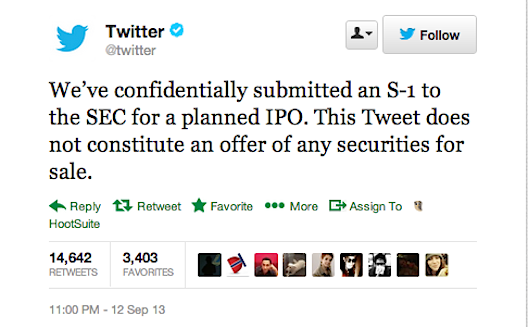A look at Twitter's IPO: what will change?


Twitter’s IPO, which it announced last week, is one of the most
hotly anticipated IPOs since Facebook. After announcing via tweet
that they filed an S-1 with the SEC- the first step to going
public- the social network has stirred up speculation across the
web that it will be valued at around $14 billion, with estimates
ranging from a
$9.8 billion valuation, based on investment by GSV Capital, to
$16 billion, and stock prices around $26 to $28.
Twitter’s yearly revenues are estimated to be around $500 to $600
million, which has allowed the company to file confidentially under
the 2012 Jumpstart Our Business Startup (JOBS) act in the U.S.,
which allows companies with less than $1 billion in revenue to file
secretly. It may have been
forced to IPO, as the JOBS act also requires any company to go
public if it has more than 2,000 private investors.
Twitter might hit $1 billion in revenue next year,
thanks to mobile advertising, but for now, its smaller size is
one reason Twitter is unlikely to emulate Facebook’s flop. An IPO
valuation of $16 billion would still only value the company at 16x
its projected revenues of $1 billion, which
looks conservative, says Peter Cohan at Forbes, compared to
Facebook trading at
18.3x its sales, and LinkedIn at
23x sales at time of print.
By going public at an earlier revenue stage, Twitter is also likely
poised for more growth than Facebook. Facebook CEO Mark Zuckerberg
even
admitted at TechCrunch Disrupt last week that perhaps he had
waited a bit too long to take the company public, which may have
added to the
hype and overvaluation.
Twitter has also picked a different bank as lead underwriter for
the IPO: Goldman Sachs, as opposed to Morgan Stanley, which also
led the disappointing IPOs of Groupon and Zynga.
As it scales, however, Twitter will have to convince a broader
demographic to join. Right now, it has 200 million users, who are
active at least once a month, and send around 400 million tweets
every day (an average of two tweets per user per day).
Facebook has hit 1 billion users last year, partly by being
accessible to the moms of the world, who are not necessarily
joining real-time, news-heavy Twitter with the same enthusiasm.
Yes, Twitter been
useful during uprisings and times where a hot global news story
invites an audience eager for up-to-the-minute updates. But how
will Twitter become a more user-friendly medium?
Here are some changes the social media platform is making:
It’s adding media to its newstream. Twitter is
already
locking down what third-party apps can build, insisting that
apps allow users to see
expanded tweets, which include embedded media. Mike Brown,
Twitter's director of corporate development, has
pointed out that the social media platform has to grow beyond a
“command line” style functionality. “We have an opportunity to
up-level the chatter on Twitter in a photo, video and narrative
that helps people understand the story,” he said.
It’s focusing on conversations. Two weeks ago,
Twitter adjusted the way that tweets appear in users’ timelines,
making conversations
appear chronologically, with older tweets showing up linked to
newer ones in the same thread. This hasn’t been rolled out for all
accounts yet, but it’s clearly designed to encourage conversation
rather than allowing comments to get lost in the stream.
It’s enhancing its mobile experience. Once Apple
rolls out iOS 7 next week, Twitter plans to release a new app with
a completely different interface, that will show
more content and less interface, eliminating its “Discover”
tab, and perhaps adding new categories: Activity, Trending, and a
place to discover people to follow, as its
new Android app does. Twitter’s acquisition of MoPub, a “mobile
advertising exchange startup,” six days ago, for $350 million, will
help Twitter keep better track of its ad inventory in real time,
AllThingsD reports.
It will sync up with TV advertising. Just over
two weeks ago, Twitter bought Trendrr, an analytics firm that
tracks social media engagement,
saying that the acquisition ““will help us to build great tools
for the rest of the TV ecosystem,” potentially targeting
users with related Twitter ads after they view a TV
commercial.
As the social media platform builds more walls around its product,
boosts up ad revenue, and adds embedded media to tweets, it will
undoubtedly look a bit more like a Facebook newsfeed. As Matt
Buchanan at the New Yorker points out, the platform may also want
to
resuscitate the direct message, in order to handle competition
from Whatsapp and Snapchat. Here it could also follow Facebook’s
lead, by offering a standalone app like Facebook messenger.
By learning from Facebook’s mistakes, Twitter has a lot to gain,
perhaps especially in the Middle East, where television is still a
healthy source of ad revenue, smartphone use is exploding, yet many
of the next wave of users to come online might not be as tech savvy
as the region’s current userbase.
Prince Alwaleed bin Talal, for one, won't be selling his shares. He
says he
sees the Twitter IPO happening in early 2014, and, following
his investment of $300 million in late 2011, he won’t be
divesting.
What do you think the IPO price will be?


